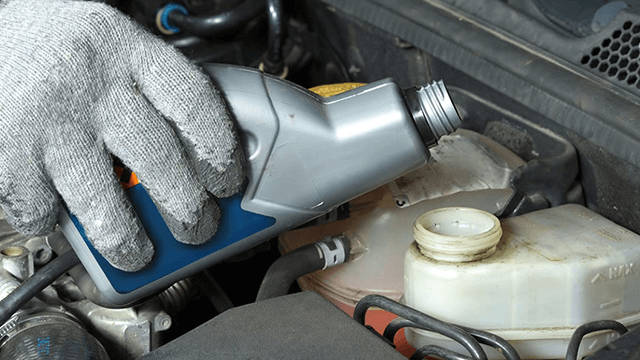
Braking fluid is vital to keep all your braking systems operating optimally. It works under high temperature and pressure. Since brake fluid is non-compressible it allows you to push the brake pedal and this pressure is delivered to the braking rotors hence bringing the car to a halt. How brake fluid operates in the car system is not that hard to understand. What becomes a challenge is the fact that we have different types of brake fluid.

Types of brake fluid
We can categorize brake fluid into two main subgroups – glycol and silicon based. Each of these subgroups are further categorized as per grade. Most of the braking fluid you find in cars with ABS is glycol based while one on cars lacking ABS or trucks is the silicone based. You cannot switch between the two braking fluids.
The US Department of transportation categorizes braking fluid based on its boiling point. The main categories are DOT 3, DOT 4, DOT 5 and DOT 5.1. The organization will present the braking fluids by its dry and wet boiling points.
The general rule is that the higher the boiling point the better the fluid. Before you can choose a particular braking point, you need to check out the car manual.
The next challenge when it comes to braking fluid is when to change it. As you continue using the braking fluid it accumulates moisture making it less effective. When this happens it is time to drain the old one and refill with new braking fluid.
Most mechanics suggest that you should change your braking fluid every two years. Considering the role of braking fluid in the car, you should be meticulous to follow stipulated changing times.
Difference between DOT 3 and DOT 4
The US department of transportation will categorize braking fluids based on a variety of factors like chemical stability, PH values, water intolerance and oxidation.
Based on this characters a value is ascribed. The glycol based braking fluids we mentioned run in category 3, 4,5, and 5.1. The most common type of braking fluid is the DOT 3. You will find it in most passenger cars.
DOT 4 has a higher boiling point hence making it ideal for use in racing cars. The problem is you cannot use a DOT 3 braking fluid in a car that runs on DOT 4 but you can use DOT 4 in a car that uses DOT 3.
Boiling point
You may be wondering why the boiling point of the braking fluid is so important. For one, you have to realize that the braking system generates a lot of pressure and heat.
If you do not have a braking fluid with a high boiling point then it will evaporate. Braking fluids also have a capacity to absorb water. The lower the boiling point the higher the absorption rate.
In this regards, DOT 3 braking fluid absorbs more water than DOT 4. When it comes to boiling point the braking fluids are rated based on dry or wet conditions.
When we talk of dry it is a new container while wet refers braking fluid having a water content of 3.7% water. The problem with braking fluid is that it gets contaminated when placed in the braking reservoir and this lowers its boiling point.
DOT 5.1 is another great braking fluid that is used in heavy duty applications and high performance cars. DOT 5 has the advantage of being silicone hence meaning it does not absorb water that much.
However, the fluid is only suitable for classic cars and is not compatible with other cars. One of its benefits is that it can remain in a car that is not driven frequently and still retain its characteristics.
Braking involves the braking rotors, calipers, brake pads and the brake pedal. The braking fluid runs all these components. When you are driving very fast the braking fluid will heat up and it can even boil.
This results to a soft pedal due to the gas that is compressible along the braking lines. In most places this is also referred as braking fade. Braking fade is dangerous as you can depress the brakes to the floor and still not experience results.
Most of the motorists often ignore checking their braking fluid. This is dangerous; it is recommended that you have your braking fluid checked and replaced at least once a year.
Chemical structure
The chemical structure of both braking fluids also differs. Most of the DOT 3 braking fluids are made from diethylen glycol while the DOT 4 fluids are made from a mixture of glycol and borate ester.
This chemical composition in DOT 4 braking fluids is what enables it to operate under extreme pressure and temperature. When tested the DOT 4 also has high dry and wet boiling points.
Braking inspection
It is imperative that you have your braking system checked occasionally. Whenever, you have faulty braking systems like a worn out rotor or braking pads you will notice that the car shakes or vibrates unnecessarily.
The first culprit would be your braking pads or rotors. The brake rotors are activated the moment you press the braking pedal and this allows the pads to cling to the rotors hence stopping the car.
This process is heat intensive and soon your braking rotors develop grooves or become warped. When you are driving you will find it takes a longer distance to bring your car to a complete halt. This can be dangerous when you are navigating sharp corners or driving at high speeds.
Braking rotors last long but not for a lifetime. Expect to experience more wobbling effects if the car has done more than 70,000 miles. Braking pads wear out faster than other braking parts.
The pads are warped around the rotors and help bring the car to a halt. When your braking pads are worn out you will notice a squealing sound. Braking pads are exposed to dirt and debris hence increasing their rate of wear.
Once you have checked your braking pads you may also want to ensure that the wheel nuts and bearings are not loose. If they are the car will wobble about during driving. Safe braking is also a factor of having a good set of tires.
If your tires are worn out then you are going to have increased cases of skids as the tire lacks friction. If they are uneven then they are going to put pressure on one side of the car leading to premature wear and tear.
Conclusion
Braking fluid is one of those things your car cannot run without. The fluid is as important as fuel and oil. However, the braking fluid is exposed to a lot of heat and moisture that hinders its smooth operation.
How you store your braking fluid will determine how it works. The US department of transport is responsible for classification of braking fluid based on various characteristics like boiling point and chemical structure. The DOT 3 braking fluid is the most common type used in many cars.
However, it absorbs more moisture than the DOT 4. The DOT 4 can be used in DOT 3 cars but the DOT 3 cannot be used in DOT 4 cars. You need to know the differences before purchasing braking fluid.
